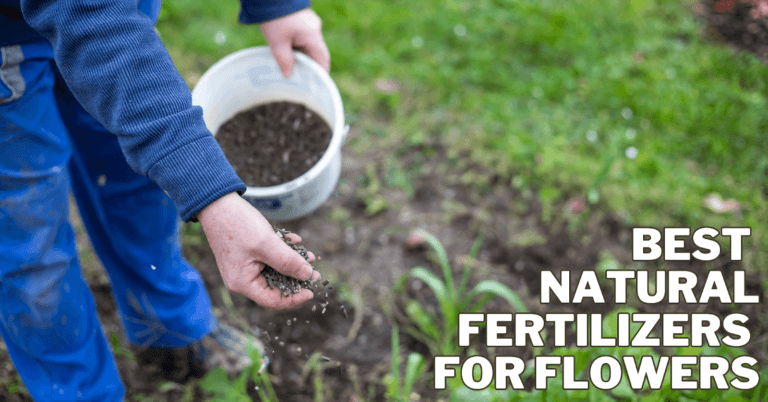Best Types Of Boxwood Shrubs
Boxwood shrubs are timeless, versatile evergreens prized for their dense foliage and easy shaping. Ideal for hedges, borders, and topiary, they add structure and elegance to any landscape.
With various types available—each differing in size, growth rate, and cold hardiness—choosing the right one can enhance both form and function in your garden.
This article will explore the most popular types of boxwood shrubs to help you select the perfect variety for your outdoor space.
Boxwood Shrub Types Explained: Find Your Perfect Match
Boxwoods come in a wide range of shapes and sizes, making them a favourite for everything from formal hedges to casual borders and container gardens. Below are some of the most popular boxwood shrub types to consider for your landscape.
1. American Boxwood (Buxus sempervirens)
- Also known as: Common Boxwood
- Bloom time: Spring (inconspicuous)
- Zones: 5–9
Features
American Boxwood is a large, upright evergreen shrub known for its dense, lush foliage and classic appeal. It can grow 15–20 feet tall if unpruned, making it ideal for privacy hedges, topiaries, and formal garden designs.
Its small, dark green leaves maintain colour throughout the year, providing year-round structure and elegance. This variety is highly adaptable, tolerating both sun and partial shade.
It is deer-resistant and moderately drought-tolerant once established, though it prefers consistent moisture and slightly acidic, well-drained soil.
How To Grow
Plant American Boxwood in well-drained soil with partial to full sun exposure. To maintain proper air circulation and ward against illness, arrange plants by their mature size.
Water regularly during the first year to establish strong roots, then reduce frequency as it matures. To keep the soil moist and control its temperature, mulch the base.
In late spring or early summer, trim sparingly to preserve shape and get rid of any dead or damaged growth. Avoid heavy pruning in fall to reduce winter injury. Apply a balanced, slow-release fertilizer in the early spring.
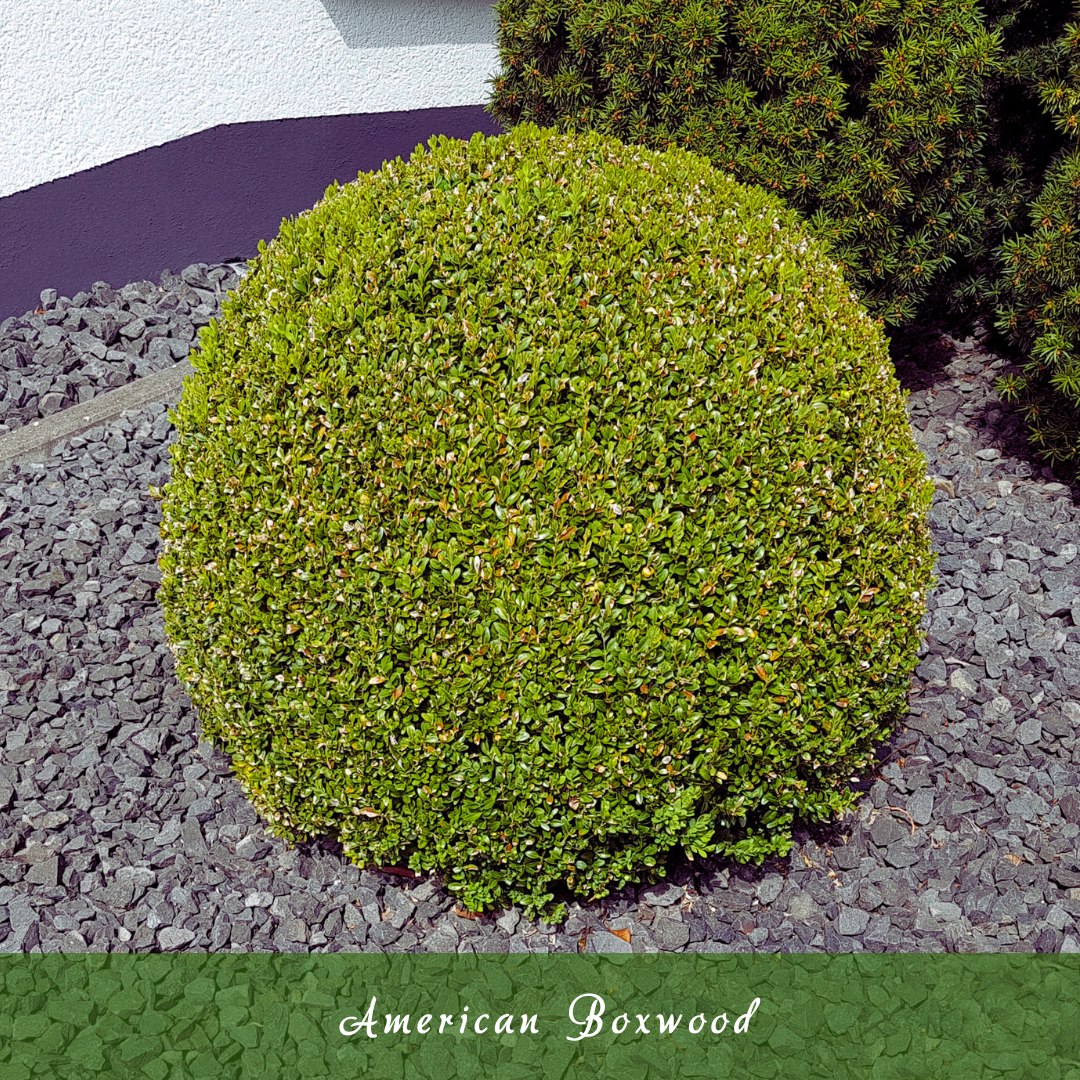
2. English Boxwood (Buxus sempervirens ‘Suffruticosa’)
- Also known as: Dwarf English Boxwood
- Bloom time: Spring (small, inconspicuous flowers)
- Zones: 5–8
Features
English Boxwood ‘Suffruticosa’ is one of the popular types of boxwood shrubs known for its dense, compact form and elegant appearance.
It typically grows 2–3 feet tall, making it perfect for formal borders, low hedges, and topiary work. Its small, glossy, dark green leaves create a classic, elegant look year-round.
This variety is slow-growing and highly adaptable, tolerating both sun and shade. It flourishes in well-drained soils and is resistant to deer, adding low-maintenance appeal to both classic and modern gardens.
How To Grow
The ideal growing conditions for English Boxwood are full sun to partial shade and well-drained soil. Water regularly during the first growing season to develop a strong root system, then water moderately.
Mulching protects roots in the winter and helps hold onto soil moisture. Light pruning can help it keep its shape and promote dense growth, either in the early spring or after flowering.
Steer clear of intensive trimming in the latter part of the season to avoid winter damage. Use a balanced fertilizer in the early spring to encourage robust growth and lush leaves.
3. Wintergreen Boxwood (Buxus sinica var. insularis ‘Wintergreen’)
- Also known as: Korean Boxwood
- Bloom time: Spring (small, inconspicuous flowers)
- Zones: 5–8
Features
Wintergreen Boxwood is one of the resilient types of boxwood shrubs valued for its vibrant year-round foliage and cold-hardiness.
It is perfect for hedges, borders, or foundation plantings because of its dense, rounded shape, which grows 3 to 5 feet tall and wide. This variety is resistant to cold, deer, and many common pests.
Its slow to moderate growth rate and evergreen nature add year-round structure and colour to landscapes, enhancing garden appeal in all seasons.
How To Grow
In healthy, well-drained soil, Wintergreen Boxwood thrives when planted in full sun to mild shade. Water regularly during the first year to establish strong roots, then reduce watering frequency.
In order to protect roots and preserve moisture during the winter, mulch the base, prune lightly after flowering or early spring to maintain the desired shape and density.
Avoid heavy late-season pruning to prevent cold damage. Use a balanced fertilizer in the early spring to promote year-round healthy, lush foliage.
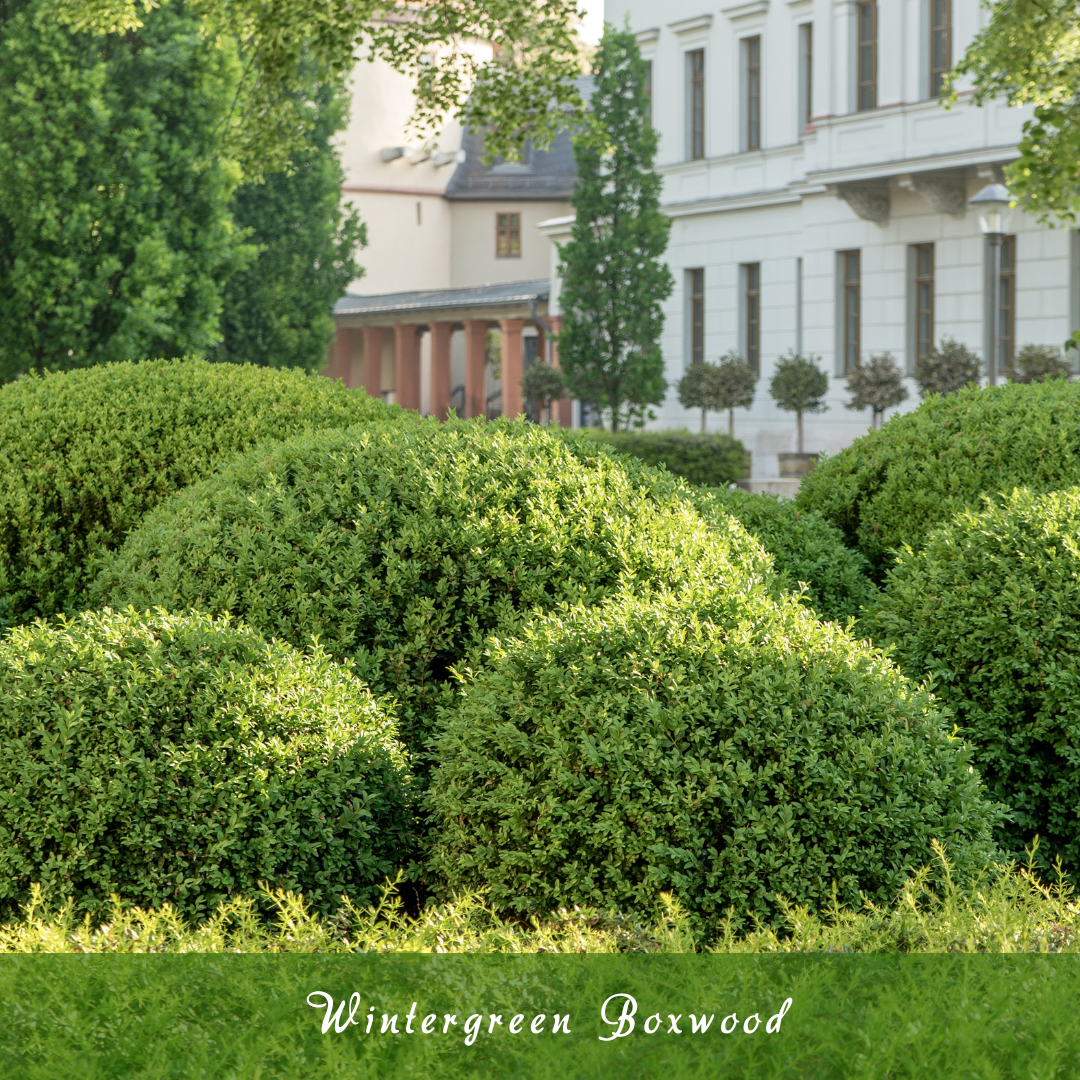
4. Green Velvet Boxwood (Buxus ‘Green Velvet’)
- Also known as: Green Velvet Hybrid Boxwood
- Bloom time: Spring (small, inconspicuous flowers)
- Zones: 5–8
Features
Dense and naturally pyramidal, Green Mountain Boxwood is an evergreen shrub that grows 4 to 5 feet tall and 3 to 4 feet wide.
Its rich green foliage holds colour year-round, providing excellent structure in landscapes. It is hardy, disease-resistant, and low-maintenance, making it suitable for formal hedges, vertical accents, or topiary.
This versatile shrub adapts well to various soils and climates, adding elegance and texture to gardens throughout the growing season.
How To Grow
The ideal growing conditions for Green Mountain Boxwood are full sun to partial shade and well-drained soil. During the first growth season, water frequently to create strong roots; as it grows more drought-tolerant, water less often.
Mulching helps retain soil moisture and protect roots. Light pruning can help preserve shape or promote denser growth in late winter or early spring.
Use a balanced fertilizer once a year to maintain healthy foliage. This shrub thrives in diverse garden settings, from formal landscapes to urban yards.
5. Golden Dream Boxwood (Buxus microphylla ‘Golden Dream’)
- Also known as: Dwarf Golden Boxwood, Golden Edge Boxwood
- Bloom time: Spring (small, inconspicuous flowers)
- Zones: 5–9 (USDA Hardiness Zones)
Features
Golden Dream Boxwood is a compact evergreen shrub known for its striking variegated foliage, featuring vibrant yellow edges contrasting with deep green centers.
Growing 2 to 3 feet tall and wide, it adds bright colour and texture to gardens year-round. This shrub is slow-growing, dense, and ideal for borders, foundation plantings, or mixed containers.
It is drought-tolerant once established, deer-resistant, and adapts well to different soil types, making it a versatile, eye-catching choice for many landscape designs.
How To Grow
Plant Golden Dream Boxwood in well-drained soil with full sun to partial shade for best foliage colour. Water consistently during the first growing season to establish roots, then reduce watering as the shrub matures.
Mulch around the base to retain moisture and protect roots from extreme temperatures. Light pruning in early spring helps maintain its shape and encourages bushier growth.
Fertilize annually with a balanced, slow-release fertilizer. This shrub thrives in garden beds, borders, and containers, providing year-round visual interest.
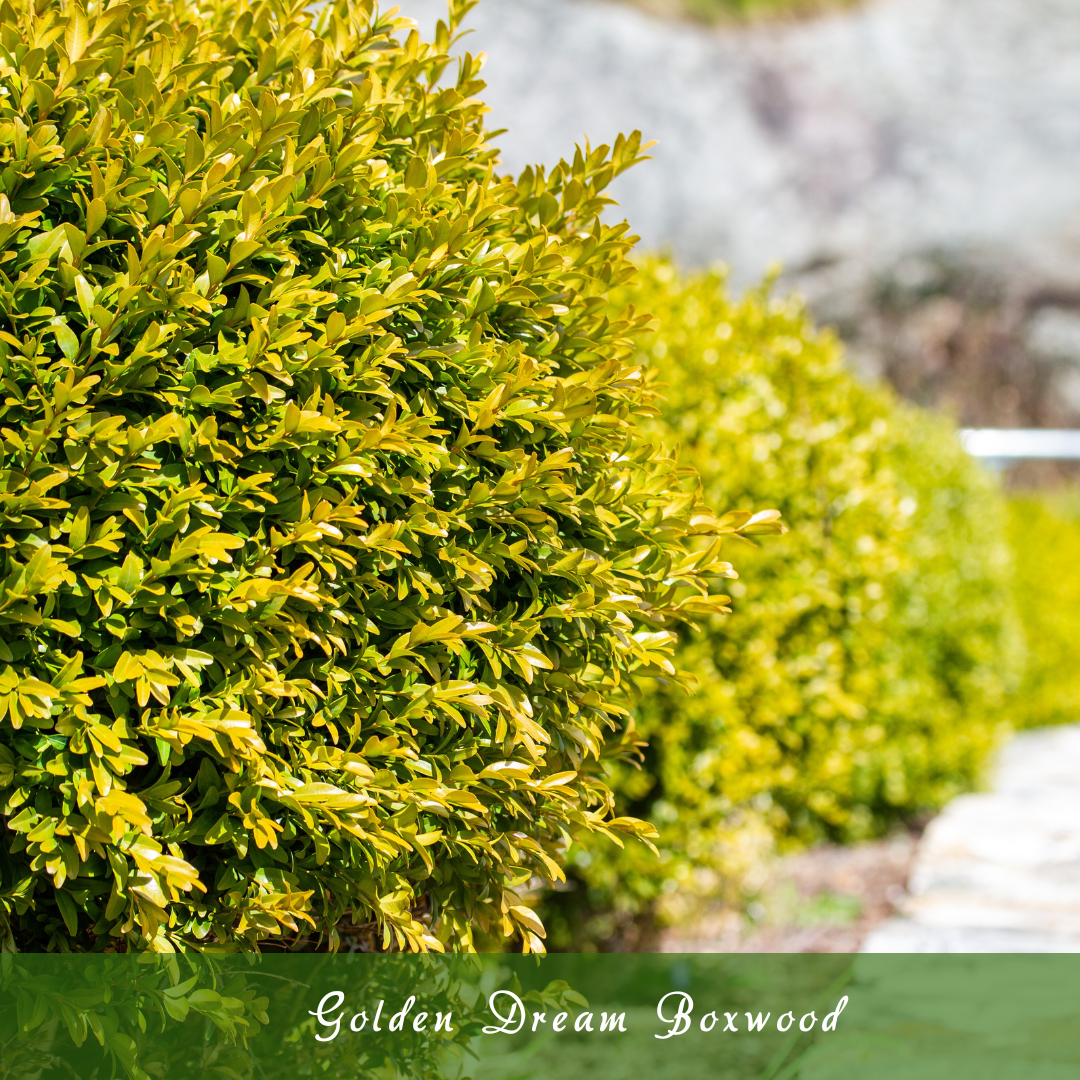
6. Vardar Valley Boxwood (Buxus sempervirens ‘Vardar Valley’)
- Also known as: Vardar Valley Boxwood
- Bloom time: Spring (small, inconspicuous flowers)
- Zones: 5–9 (USDA Hardiness Zones)
Features
Vardar Valley Boxwood is a low-growing, hardy evergreen shrub prized for its dense, compact form and bluish-green foliage that maintains colour well through winter.
It typically grows 2–3 feet tall and spreads 3–4 feet wide, making it perfect for ground cover, borders, or foundation plantings.
This variety is drought-tolerant, deer-resistant, and adapts well to various soil types. Its winter colour retention and low maintenance needs make it an excellent choice for year-round landscape interest.
How To Grow
Plant Vardar Valley Boxwood in full sun to partial shade with well-drained soil for optimal growth. Water consistently during the first season to establish strong roots, then reduce watering as the plant becomes drought-tolerant.
Apply mulch to conserve moisture and suppress weeds. Prune lightly after flowering to maintain shape and encourage dense growth. Fertilize in early spring with a balanced fertilizer if needed.
This boxwood thrives in cold climates and urban environments, requiring minimal care while adding durable, year-round beauty to your garden.
Turn Your Passion for Nature Into Income
🌿 Whether you love gardening, caring for animals, or exploring holistic living,
You can share your knowledge online and earn from it.
Discover how nature lovers are growing their passions into meaningful, income-generating blogs. 👇
7. Dee Runk Boxwood (Buxus sempervirens ‘Dee Runk’)
- Also known as: Dee Runk Boxwood
- Bloom time: Spring (small, inconspicuous flowers)
- Zones: 5–9 (USDA Hardiness Zones)
Features
Dee Runk Boxwood is a distinctive type among types of boxwood shrubs, prized for its tall, narrow shape and year-round dense foliage.
It grows steadily to about 6–8 feet tall and 2–3 feet wide, providing excellent privacy screening or architectural interest. The thick, glossy green foliage holds its colour year-round and adapts well to various soil types.
This variety is low-maintenance, deer-resistant, and drought-tolerant once established, making it perfect for formal gardens and urban landscapes.
How To Grow
Plant Dee Runk Boxwood in full sun to partial shade with well-drained soil for best growth. Water regularly during the first growing season to establish a deep root system, then reduce watering as it becomes drought-tolerant.
Mulch around the base to retain moisture and suppress weeds. Prune lightly in late winter or early spring to maintain its narrow shape and encourage dense growth.
Fertilize in early spring with a balanced fertilizer. This boxwood thrives in urban and suburban settings, offering easy care and elegant vertical structure.
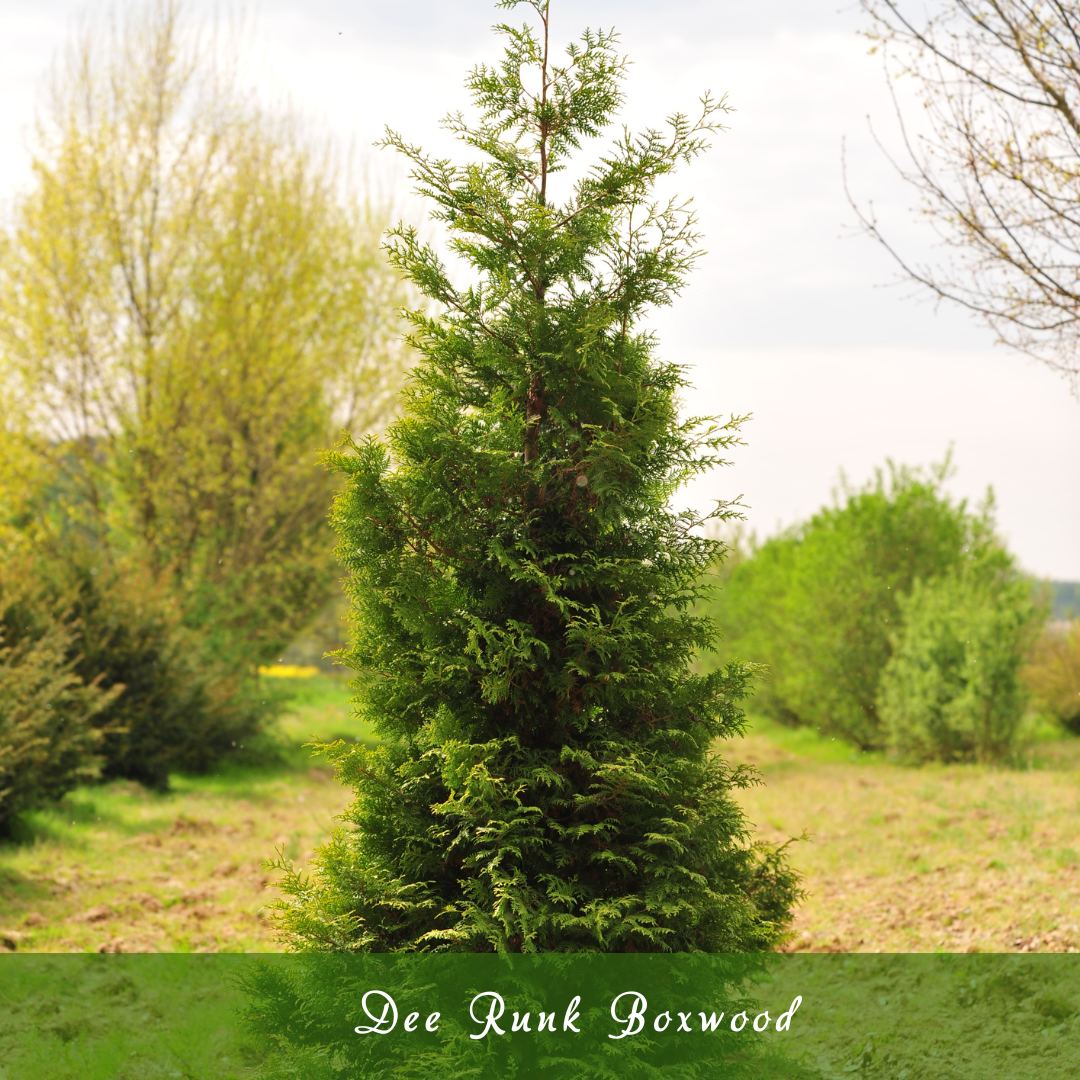
8. Northern Charm Boxwood (Buxus ‘Northern Charm’)
- Also known as: Northern Charm Boxwood
- Bloom time: Spring (small, inconspicuous flowers)
- Zones: 4–8 (USDA Hardiness Zones)
Features
Northern Charm is one of the most reliable types of boxwood shrubs, valued for its cold hardiness and dense, rounded growth habit. It grows about 2 to 3 feet tall and wide, holding its rich green colour throughout the seasons, even in harsh winters.
Resistant to winter burn and adaptable to various soil types, it offers year-round structure and beauty with minimal upkeep. Its compact habit and tidy appearance make it a popular choice for both formal and casual gardens.
How To Grow
Plant Northern Charm Boxwood in well-drained soil and full sun to partial shade for best results. Water regularly during its first growing season to establish a strong root system.
Once established, it is moderately drought-tolerant and requires less frequent watering. Add mulch to conserve soil moisture and regulate temperature. Prune lightly in early spring to maintain its shape and encourage healthy growth.
Fertilize annually with a balanced, slow-release fertilizer. This low-maintenance shrub performs well in cold climates, providing reliable structure and colour to your landscape all year.
9. Elegantissima Boxwood (Buxus sempervirens ‘Elegantissima’)
- Also known as: Variegated Common Boxwood
- Bloom time: Spring (inconspicuous, pale green flowers)
- Zones: 6–8
Features
Elegantissima Boxwood is prized for its striking variegated foliage, featuring deep green leaves edged in creamy white. This evergreen shrub adds year-round ornamental contrast to borders, foundations, and formal gardens.
Its compact, upright growth habit makes it ideal for low hedges or decorative accents. It grows slowly, typically reaching 3–5 feet tall and wide. Tolerant of pruning, it maintains shape well and fits neatly into structured landscapes.
With its unique colouring and manageable size, it brings both elegance and versatility to mixed plantings or monochromatic designs.
How To Grow
Plant the Elegantissima Boxwood in partial shade to protect its light-colored leaves from scorching in intense sun. It prefers moist, well-drained soil rich in organic matter and benefits from mulching to maintain even soil moisture.
Water regularly during establishment, then only during prolonged dry spells. Prune lightly in late winter or early spring to shape and remove deadwood. Avoid harsh shearing to preserve its natural texture.
This variety is moderately tolerant of urban pollution and makes a standout specimen in containers, formal beds, or shade gardens.
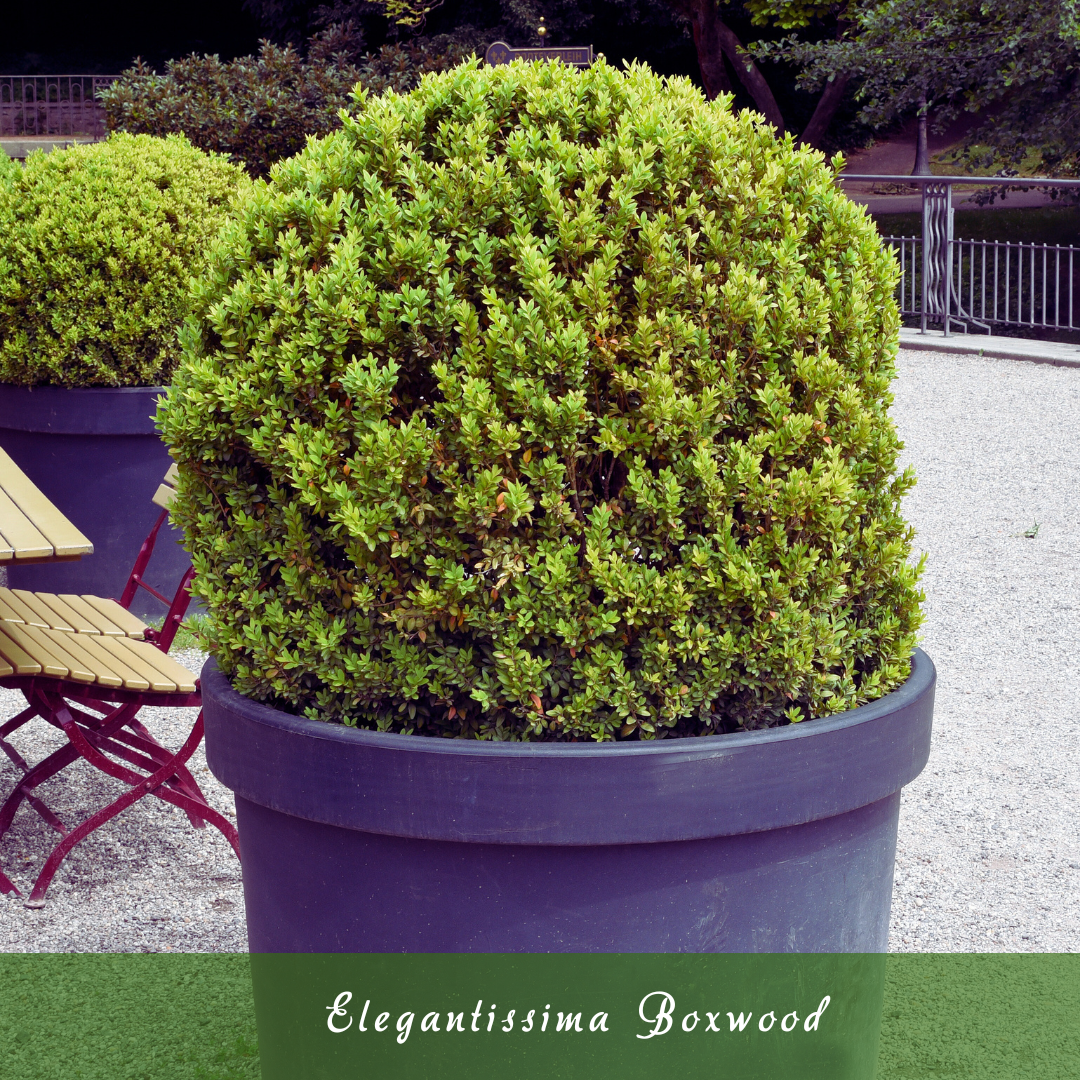
10. Rotundifolia Boxwood (Buxus sempervirens ‘Rotundifolia’)
- Also known as: Roundleaf Boxwood
- Bloom time: Spring (small, pale greenish-yellow flowers)
- Zones: 6–8
Features
Rotundifolia is one of the versatile types of boxwood shrubs, prized for its larger leaves and vigorous growth, ideal for lush hedges and topiary.
This vigorous evergreen grows faster than many other boxwood types, reaching 5–6 feet tall and wide, making it excellent for dense hedging or large-scale landscaping. Its rounded leaf shape and bright foliage add texture and depth to formal or informal garden styles.
With a naturally bushy form and strong visual presence, Rotundifolia is both practical and attractive in screening, foundation plantings, or as a clipped topiary feature.
How To Grow
Plant Rotundifolia Boxwood in a location with partial shade to full sun, avoiding intense afternoon heat in warmer zones. It prefers well-drained, loamy soil enriched with organic matter.
Water regularly during its first growing season to establish deep roots, then as needed based on rainfall. Prune in late winter or early spring to shape or maintain size.
Its rapid growth means it may require more frequent trimming than slower boxwood varieties. Mulch annually to conserve moisture and insulate roots. Ideal for hedges, borders, or large-scale formal plantings.
How To Choose The Right Boxwood Shrubs For Your Garden
Understanding the different types of boxwood shrubs helps you select the perfect variety to match your garden’s style and growing conditions. Here’s how to make the best choice.
1. Consider Your Climate
Climate plays a key role in selecting the right boxwood. In colder regions, choose varieties bred explicitly for winter resilience, such as Northern Charm or Vardar Valley.
These cultivars are less prone to winter burn and can survive harsh conditions in USDA zones 4–5. Southern gardeners have more flexibility but should avoid cold-sensitive types in the north.
Always check the zone hardiness before planting. Choosing the wrong variety for your climate can result in poor health, leaf discoloration, or even plant loss during extreme temperature changes.
2. Think About Growth Habit
Boxwoods come in a range of shapes and sizes, so it’s essential to match their growth habit with your design needs. For narrow spaces or vertical interest, columnar varieties like Dee Runk are ideal.
They add structure without taking up much ground space. If you're looking to edge a path or define a border, choose compact, rounded types like Green Velvet or English Boxwood.
Understanding growth habits helps prevent overcrowding and keeps maintenance manageable while achieving a balanced, intentional garden layout over time.
3. Match Sunlight Conditions
While boxwoods generally prefer partial shade, sunlight tolerance varies by cultivar. For example, Green Mountain can tolerate full sun, provided it receives adequate water and protection from intense afternoon heat.
In shadier areas, most varieties will thrive with minimal issues. Knowing how much sun your garden gets will help you avoid scorched leaves or leggy growth.
Morning sun with afternoon shade is ideal for many boxwoods. Constantly monitor moisture and mulch around the base to maintain even soil temperatures in sunnier spots.
4. Decide On Formal vs Casual Style
Boxwoods are favourites for formal landscapes because they respond well to pruning and shaping. If your garden style leans formal, choose tightly growing types like American or English Boxwood for neat hedges or classic topiary shapes.
On the other hand, if you prefer a more relaxed, naturalistic look, go with looser-growing varieties that don’t require constant trimming.
These are easier to maintain and blend well with mixed plantings. Defining your garden style early on ensures your boxwoods complement the overall design.
Conclusion
Boxwood shrubs offer timeless charm and versatility for gardens of all styles. The many types of boxwood shrubs available ensure you can find the ideal fit for both formal and casual garden designs.
Their year-round greenery, adaptability, and classic appeal make them suitable for borders, screens, and ornamental accents.
Whether you're aiming for formality or a natural look, boxwoods provide structure and beauty with minimal care. Choose the right variety, and enjoy lasting elegance in your outdoor space.
I trust you enjoyed this article on the Best Types Of Boxwood Shrubs. Please stay tuned for more inspiring guides, helpful tips, and ideas to help you live closer to nature every day.
Take care!
— JeannetteZ
💬 Your Opinion Is Important To Me
Do you have thoughts, ideas, or questions? I’d love to hear from you. Please leave your comments below or email me directly at Jeannette@Close-To-Nature.org.
📚 More Nature-Inspired Reads
Explore more ways to connect with nature, nurture your pets, and live in harmony with the world around you 🌿


